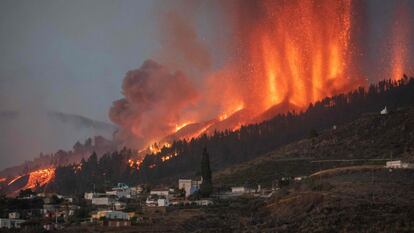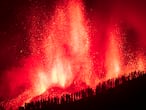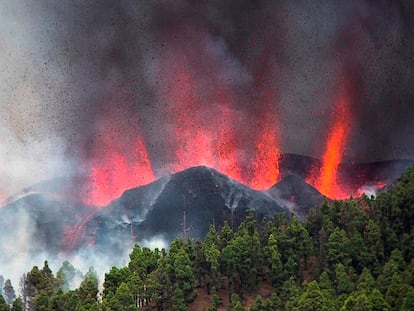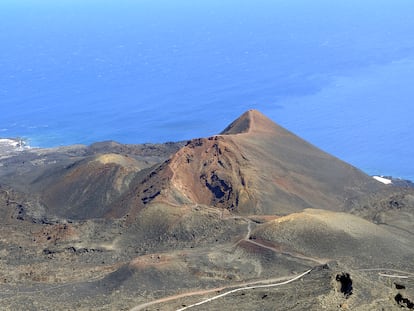Lava from volcanic eruption on Canary Island razes around a hundred homes
Spanish Prime Minister Pedro Sánchez has canceled a planned trip to the US and has flown to La Palma to oversee operations. The eruption could last ‘several weeks or a few months,’ according to one expert
The Spanish Civil Guard evacuated around 5,000 people from their homes last night after a volcanic eruption took place on the Spanish island of La Palma at 3.12pm local time on Montaña Rajada, in the forest area of Cabeza de Vaca in El Paso. The emergency level was raised to red at 5pm local time, affecting the municipalities of Tazacorte, El Paso, Fuencaliente, Mazo and Los Llanos de Aridane, which are home to a total of around 35,000 people. La Palma is part of Spain’s Canary Islands, located off the northwestern coast of Africa.
The authorities had estimated that as many as 10,000 people might have to be evacuated from their homes, and recommended to residents that they close all windows and exterior doors, close window blinds and turn off their supplies of water, gas and electricity before making their way to the established meeting points. There have been no reported victims or injuries so far, but by Monday morning the local authorities were estimating that lava flows had destroyed around a hundred homes in El Paso.
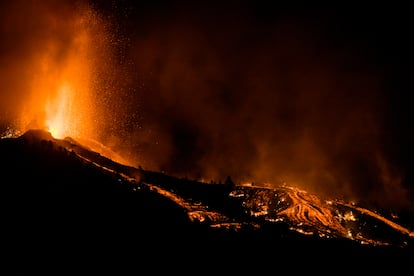
An exclusion zone of two kilometers was established around the area in order to minimize the impact of airborne particles and gases. The eruption created two fissures that are 200 meters apart, with lava reportedly flowing from eight different points
“It is not likely that anyone else will need to be evacuated,” announced the regional premier of the Canary Islands, Ángel Víctor Torres, speaking at a news conference at around 10.30pm local time (one hour behind mainland Spain) last night. “The lava is moving toward the coast and the damage will be material.” Torres explained that some “17 to 20 million cubic meters of lava” was being released in the eruption. “Everything points to there not being new eruption points,” he continued. “There may be some other fissures but the safety of citizens is guaranteed.”
Con motivo de la #ErupciónLaPalma hay 7 carreteras cortadas en ambos sentidos.
— Guardia Civil 🇪🇸 (@guardiacivil) September 20, 2021
✔LP301 y LP212 en El Paso
✔LP214, LP211 y LP213 en Los llanos de Aridane
✔LP105 en San Andrés
✔LP2 en Tajuya
Estamos alertando de las incidencias en los puntos conflictivos. pic.twitter.com/v3sJw4kFIm
On Monday morning, the Civil Guard confirmed via a tweet that there were seven roads cut off in both directions due to the eruption. These are the LP301 and LP212 in El Paso, the LP214, LP211 and LP213 in Los llanos de Aridane, the LP105 in San Andrés and the LP2 in Tajuya.
A small earthquake in the Las Manchas neighborhood in El Paso preceded a huge explosion yesterday afternoon, which was followed by an enormous plume of smoke and the expulsion of airborne fragments known as pyroclasts. The volcano erupted in an uninhabited area of the mountain, and caused a number of small forest fires. The authorities requested that no one approach the area.
The eruption in La Palma could last “several weeks or a few months,” according to the director of the Canaries’ Volcanology Institute, Nemesio Pérez. Speaking this morning on the Cadena SER radio network, he explained that the duration would depend on the amount of magma that had accumulated in the volcano’s “reservoir.” He added that the emissions of sulfur dioxide from the volcano will need to be studied in order to help determine how long the episode will continue. “The first day we calculated between 6,000 and 9,000 tons, and a falling trend will be indicative of a diminishing eruption,” he explained. “Once 48 hours have passed with no emissions, we can conclude that it has ended.”
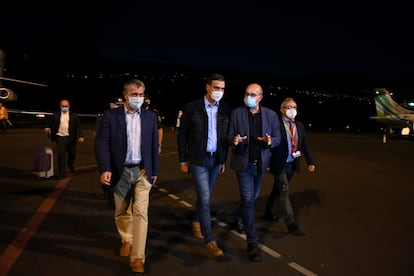
Spanish Prime Minister Pedro Sánchez, who yesterday canceled a trip to New York for the United Nations General Assembly so that he could travel to La Palma and oversee operations there, will today visit one of the shelters for people who were evacuated from their homes due to the eruption. The center is located in El Fuerte and is being run by the Red Cross. He will be accompanied by the interior minister, Fernando Grande-Marlaska. Sánchez yesterday gave a guarantee that the inhabitants of the affected areas would be safe, and stated that assistance would be expedited for those who have suffered material losses and damage.
The air navigation manager in Spain, Enaire, recommended that no flights land on the island. Airlines have the final say as to whether they fly to La Palma, given that air traffic was not officially closed. The Canary Islands’ regional premier, Ángel Víctor Torres, said on Monday morning that the volcano had already emitted more than 20,000 tons of sulfur dioxide. The wind conditions, however, meant that this was not forcing the closure of the airport on the island for now.
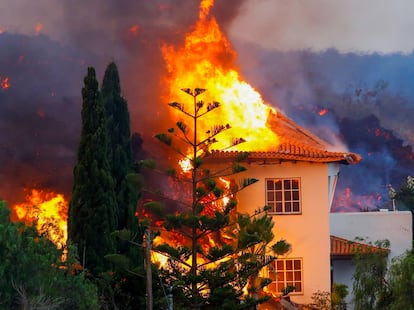
The mayor of El Paso, Rodríguez Fernández, told EL PAÍS last night that the lava had damaged some houses, but that in principle it “will not be problematic.” He also said that around 350 people were headed last night to the local soccer pitch where they would be staying until the situation was under control. “The area is totally evacuated, it is safe for people but not for infrastructure,” he told the Cadena SER radio network on Monday morning. “The ash is an added danger, but it is difficult to control.” The local education board decided to cancel classes for Monday in El Paso, Los Llanos de Aridane and Tazacorte, according to Canarias Radio.
The eruption followed a series of constant small tremors, known as an earthquake swarm, which began on September 11 in Cumbre Vieja national park in the south of the island. The fast process, which has been releasing large amounts of energy, sparked the eruption in an area that had not been active since 1971.
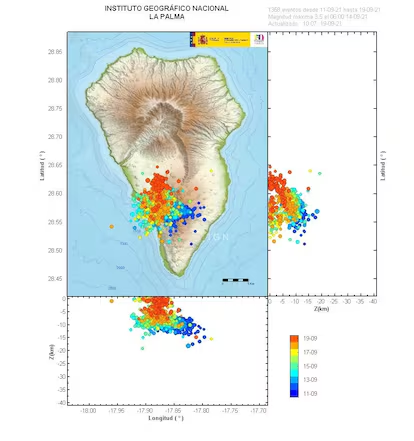
English version by Simon Hunter.
Tu suscripción se está usando en otro dispositivo
¿Quieres añadir otro usuario a tu suscripción?
Si continúas leyendo en este dispositivo, no se podrá leer en el otro.
FlechaTu suscripción se está usando en otro dispositivo y solo puedes acceder a EL PAÍS desde un dispositivo a la vez.
Si quieres compartir tu cuenta, cambia tu suscripción a la modalidad Premium, así podrás añadir otro usuario. Cada uno accederá con su propia cuenta de email, lo que os permitirá personalizar vuestra experiencia en EL PAÍS.
¿Tienes una suscripción de empresa? Accede aquí para contratar más cuentas.
En el caso de no saber quién está usando tu cuenta, te recomendamos cambiar tu contraseña aquí.
Si decides continuar compartiendo tu cuenta, este mensaje se mostrará en tu dispositivo y en el de la otra persona que está usando tu cuenta de forma indefinida, afectando a tu experiencia de lectura. Puedes consultar aquí los términos y condiciones de la suscripción digital.
More information
Últimas noticias
Alain Aspect, Nobel laureate in physics: ‘Einstein was so smart that he would have had to recognize quantum entanglement’
Imelda Castro, the woman who wants to rule the cartel battleground of Sinaloa
The new victims of the Republican war on Obamacare: Millions hit by soaring health insurance premiums
A country divided on migrant rights: Some US states expand protections while others restrict them
Most viewed
- David King, chemist: ‘There are scientists studying how to cool the planet; nobody should stop these experiments from happening’
- Reinhard Genzel, Nobel laureate in physics: ‘One-minute videos will never give you the truth’
- Oona Chaplin: ‘I told James Cameron that I was living in a treehouse and starting a permaculture project with a friend’
- Sinaloa Cartel war is taking its toll on Los Chapitos
- Mexico completes its trade shift with the entry into force of tariffs on China and countries without trade agreements
